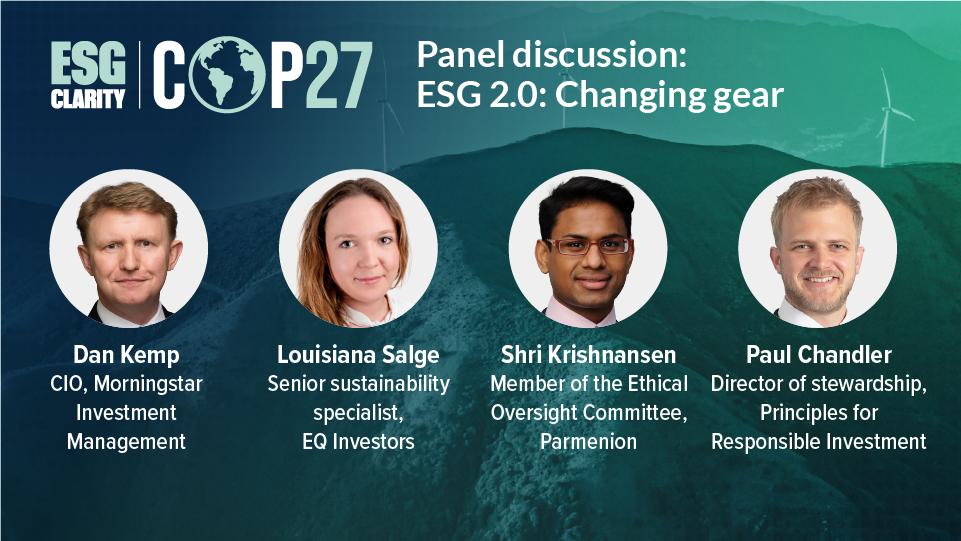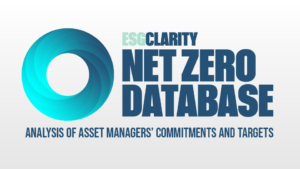Innovation, engagement and collaboration are the areas that will propel sustainable finance forward, according to panel of experts who joined ESG Clarity‘s Natalie Kenway in the London studio for this very special recording.
The experts dissected the current challenges around active stewardship and where the industry can move forward together, as well as how having more public discussions around engagement will benefit the economy and transition to net zero.
The panellists:
- Dan Kemp, CIO, Morningstar Investment Management
- Louisiana Salge, senior sustainability specialist, EQ Investors
- Shri Krishnansen, member of the Ethical Oversight Committee, Parmenion
- Paul Chandler, director of stewardship, Principles for Responsible Investment
The full panel discussion can be viewed in the video above and a transcript is below.
See also: – All ESG Clarity‘s COP27 coverage

NK: Welcome to this very special panel discussion on ESG 2.0: Changing gear where we will be discussing the ESG investment industry and the next steps from today. I’m joined by a group of industry experts, thank you so much for joining me.
First of all, I wanted to ask you about some of the things that we’ve seen this year, the critics we’ve seen against ESG, the underperformance, but they’ve also been some positive steps taken this year; We’ve seen some innovation, a lot of launches, and we’ve even seen fund flows when traditional funds have seen outflows. What other positive steps has the industry taken? Louisiana, Ill come to you first,
LS: Sure. So, EQ Investors is a sustainable wealth manager, just for the perspective, and we manage different types of sustainable portfolios. And I think what we need to remember is that sustainable investing is just isn’t just one thing; the underperformance that people are citing can look quite different depending on what sustainable objectives you set.
And with that in mind, we were really pushing our fund managers to expand the universe for us and the universe of funds for us.
You mentioned innovation in this space – we’ve been co-launching and seeding multiple funds like green infrastructure funds and I would say sustainable and impact strategies. This is the way that we’ve been using this point of volatility to innovate and continuously push, but also remember why we’re investing like this and why are clients investing this way, and usually they’re investing with a sustainability objective as well as a financial performance objective. It’s the long term that we’re looking at and we still stand strong that these two are very supportive of each other.
NK: OK, fantastic. I know it’s not on your side of the business at Morningstar, Dan but we’ve seen some data come through in terms of fund flows that I’ve mentioned. What are you seeing on the [investment management] side of the business Which positive steps?
DK: I think the underperformance is really positive. I know it’s not that we seem that way, but I think we’ve got into a position where people have forgotten that ESG investing is investing. And when you’re investing, if you’re thinking about your client’s time horizon, then what’s likely to drive returns is the valuation of the assets you invest in.
And a lot of what was thought of were marketed as ESG propositions have an enormous amount of very expensive holdings. This was obvious and talked about at the time. And there was this belief that holdings could carry on getting more expensive to defy the natural laws of investments because they were targeted more towards lowering of ESG risk.
So actually what this year has done is remind us that ESG is a form of investing. It’s a growing form, incredibly important form, and it’s vital as a way of connecting people with their portfolios. But it is investing, it obeys the same rules. Now that we understand that, better than I think some people understood it over the last few years, I think we’ll have a much more mature approach going forward and people can look forward to higher returns as well as be able to connect the values with their portfolios.
NK: Great. Thank you. And Paul, with your oversight at the PRI, what would you say are the steps you’ve seen that have been a good step forward for us?
PC: I think the criticism of ESG this year has been present obviously but I think it’s also been welcomed in much like the underperformance maybe, it’s a good step for the industry to go through. I think having grown so quickly over the last few years, having a bit of healthy scepticism about what ESG is for and what it can achieve, I think is a really important thing.
It’s very important for us to ask and answer this questions. I think one thing that we’ve really welcomed over the one to two years has been an increasing focus on systematic risk. Investors starting to understand that there are decisions that you can make, such as capital allocation decisions or prioritising alpha, and that’s an important part of the industry, but also we’re all exposed to the risk of failure to address climate change, for example, and we are at risk of economic growth being slowed by rising inequality. These kind of factors are growing in focus for investors, which is which is very much welcome. And I think something we should encourage even more thinking around.
NK: Shri, you’re relatively new to your current role, what has struck you since you’ve joined or what have you been surprised about?
SK: The last time I was involved in sustainable business was three years ago. It’s nice to come back into the industry and see how much it’s grown. Like it has been said, this year is a great time to really challenge some of those beliefs and misconceptions around sustainable investing, ESG and ethical. I think what I’ve noticed is there’s much more granularity in awareness from end users. When you exclude certain things or when you overweight certain things there are different patterns of performance that perhaps I think naively when you’re in a market that’s always rising, you don’t always fully appreciate. Last time I was in the industry sustainability was the best performing style for the year, but when you exclude things, or you start to say well actually I’m a value aligned investor and I have to accept a different level of performance, I have to accept a different style with certain biases like growth etc because you’re in these tech companies that have lower carbon footprint…it’s interesting to see people are now starting to understand that better.
At Parmenion we work with a lot of advisors who distribute our funds and we’re seeing the granularity of the questions coming back. They really start to show more appreciation and understanding of certain trade-offs. So, for example, people trying to understand animal testing, may want to screen out non-medical related animal testing.
It’s pleasing to see up to three years away from it all that people are trying to understand exactly what their decisions benefitting from and [impact on] performance.
DK: I think that’s so encouraging – putting together Shri’s and Paul’s comments, on the one hand there’s that focus on ESG risk assessment, which can be priced, and on the other hand there’s that expression of an investor’s preferences like animal testing, which is which is a different thing, and that’s potentially unpriced and people can decide that regardless of the investing opportunity, they don’t want to be involved animal testing. That gives us really well that combination of what ESG is, which was really kind of all mashed together a little while ago, but there’s some clarity there now for people.
NK: Thank you all. I wanted to ask about where we can be maybe taking a step forwards from here. Looking back on this year, one of the biggest themes has been engagement. A lot more companies are talking about that now and we’ve seen more voting than ever before.
But then we’ve also seeing people hiding behind engagement and using that to perhaps greenwash or engagement-wash. Paul, I know this is an area that you’re focused on so where do you think the industry can improve from here from an engagement perspective?
PC: It’s a really important question and, although I haven’t heard engagement-wash before, I think for us there’s a growing focus on how stewardship overall, not just engagement, but voting and using influence through board seats and even going as far as litigation, which we’ve seen recently coming into the into the mix, these are really important tools for investors to use their influence.
What we’d like to see is a growing comfort amongst the investment community and applying all of these tools in a way that gets outcomes for the performance of companies and the economy, but also for people and planet. What we’re hoping to see is growing comfort using those tools and we are really looking to see more collaboration across the industry, between investors and civil society or with government, for example. It’s a really important area. The other big thing is really the resourcing of stewardship. I know we talk a lot about things like how many engagement meetings have been done, but it’s not really a good measure.
It is very easy to gain that as a particular metric, which is why we’ve removed them from our reporting framework. But that doesn’t negate the need for the industry all the way down the investment chain to be thinking about [whether] the level of resourcing that we have for stewardship, for engagement, is that enough at the moment? And we would say probably not.
That’s a conversation and a dialog we we’d like to have across the industry in the next year or so.
NK: Louisiana, what are you asking asset managers about engagement?
Yeah, that’s a good question. At EQ, we have strategic engagement teams that we think are either underrepresented in the asset manager industry or they’re very material across our holdings. Just taking a couple of examples, if we look at climate change and COP27 that is ahead of us, it’s really important. Last year was the year of the commitments and this year wass the year of strategies being developed, but these strategies had significantly different ambitions. And one of the key differences between these strategies was the level of engagement ambition and the strategy of which was which was applied by these asset managers.
So, a couple of things that we’re asking them is it’s very important to have an escalation process. If you don’t have an escalation process, there’s no teeth in this. There needs to be milestones, there needs to be objectives set against these milestones and reporting against these milestones, and there also needs to be consequences. A real engagement strategy on that zero, let’s say, can’t really be justified unless there’s a real consequences to the lack of progress against these milestones. What we’re asking them to do is reporting against that and will be expecting that to come out of the next two years’ reporting cycle hopefully and totally would support you [PRI]… We do not want to maximize the number of engagements, we want them to prioritise this and tell us how they’re prioritising it. It’s really exciting.
PC: That’s really good to hear and on that point about escalation is so important because sometimes we hear about investors who, I don’t know it all gets to hard and they choose to go and divest.
And divestment is is okay, there’s a role for divestment, but there are so many other tools and so many other steps that can be taken before that which we’d love to see the community really developing and deploying more forcefully and more publicly before they start to divest.
DK: And I think linked to that as well is, once you divest from a business, you probably lower the price if you are an aggressive seller. So, what you’re really doing is increasing the expected returns for the buyer with an asset who may not care, and so actually you’re putting higher returns in the hands of a group of people who don’t share your values.
So actually, divestment definitely has a has a downside as well. But what, what I find so interesting at the moment, we have got those table stakes engagements, which I think is so important, and a lot of engagement is being done by ESG managers of some description but now that there’s a greater focus on ESG risk, then actually that’s something that all investment managers need to engage in.
It’s not a moral issue and it’s not environmental issues, its not for the people that care deeply – it is actually for everyone, because if you lower the ESG risk in a business, then you can increase the expected long term returns. I think it’s that broadening out of engagement as well as that deepening engagement, which is really exciting.
NK: Shri, do you have anything to add to on the engagement point?
SK: This idea of limited resources that has been mentioned, and Paul is right, we just don’t have enough people focused on engagement. I’m so tired of seeing when you go to a meeting and they ‘these are the number of engagements we’ve had, these are the number of companies we’ve engaged with’… that’s great, but actually what are these engagements? Are they just sending emails and letters? I want to know the quality of engagement and also, I’d like to see managers take a more focused approach in terms of what’s in their sphere of influence. For example, knowing exactly what can you make a material change in given the amount you’re investing and you also have influence, versus whether you need to go in collectively or with other people.
The idea of collectivism, which I know the PRI is very much behind, I’d love to see a bit more method to it. And then when I’m when I’m speaking and triaging different fund managers who say ‘we are engaging on this because of that and in other ways where we’re driving whole change, systemic movements, where we’re engaging with third parties because we can’t just drive that change because we only have like 2.2 basis points or something’. It’s about getting that awareness and getting that targeted approach.
NK: Okay, fantastic. Another way the industry is talked about as all taking a step forward together is collaboration, and there have been so many announcements recently about different groups working together and pushing for different ESG factors.
But then there’s also been something that has been said to me is that collaboration could be a double edged sword and you’re only as good as the lowest common denominator. Is that something that you agree with or is collaboration overall a real big positive for us?
SK: I think collaboration is very much a big positive and that’s how I ended the last question – want more collaboration. The idea of collaboration being only as strong as the weakest member, I don’t buy into that because there’s also scale benefits. There are some small investors that just won’t be able to have that sphere of influence without you.
I don’t think you can just discount the entire time movement just by the smallest. And we definitely need a lot more collaboration to drive systemic change at the government and policy level and at industry level. Look at what lobbyists do in the States, not for the good, but to show you the ability of collaboration to drive change. Let’s just use it for the right reasons going forward and we are such a big industry, financial services, we can really move the dial if we just kind of connect, enhance and move forward.
NK: Louisiana, you wanted to add to that?
LS: Collaboration is interesting, and I personally think everybody can gain from it. Unfortunately, I think a lot of people are not doing it sometimes because of competitive purposes, which I think is a bit of a shame because they don’t necessarily want to share. Especially if we’re thinking about active fund management and we think about very proprietary types of ways of analysing certain companies, they don’t necessarily want to share all of the research that they’ve invested in. I think there’s ways around this, though. So, if you have very targeted engagement groups, I think there’s no way that this actually will happen because you can have a common outcome that both of them want to achieve and therefore you will keep it to just that particular outcome and you will galvanize the AUM around this.
I was actually on a call with Rolls-Royce two days ago. EQ Investors manages under £2bn AUM – I would never get that call without collaborative engagement. I happen to have a specific interest in this one thing, and this happened to benefit the group in that particular case – in other causes it can be different. Other things that we need to engage with together is our own approaches to sustainable investing, it’s not just with changing the underlying companies, but it’s what is the best practice in a net-zero strategy, how do you integrate biodiversity risk into your investment propositions. Yesterday I was on the call with your colleagues at Parmenion about how we’re dealing with TCFD. I think there’s different layers where engagement needs to happen, and it’s great that it happens in different circles as well.
DK: I just want to challenge that point about competitiveness. I’ve been involved in ESG for over a quarter of a century and actually it’s the area of the financial services business that’s always seemed the most collaborative and the least, not competitive in terms of not wanting to do a good job for investors, but competing against each other. It’s the part of the industry where one understands that we’re trying to do something that’s bigger than just delivering returns for investors.
One of the challenges, frankly, with collaboration is a legal one around coordinating on voting. So you have to be really careful in terms what you do with collaboration, and there are lots of groups – PRI, UKSIF – that are bringing people together for informal conversations.
But I think one of the reasons why people are careful about what they’re talking about with collaboration is to make sure that they don’t breach those rules in terms of coordinating on voting. I think it seems to me that as we talk with managers and groups there is more going on below the surface.
There’s just not as much happening in the open, which is difficult for investors and difficult for advisors because they may not be able to see that. But if you’re more deeply involved as we all are, then I think we can see more that’s going on is not there’s not seen publicly.
NK: Paul, I have got to come to you on the collaboration point. What would you say is the PRI message on that?
PC: We are probably the biggest network in terms of coordinating collaborative engagement. We’ve been doing that for ten years now and we are one of the partners behind ClimateAction100+. We’re about to launch a new initiative called Advance on Social Issues and Human Rights, and these are big initiatives. I think we are getting large mainstream investors who previously had some concerns with competition and legal, and they’re getting more comfortable with that.
I think the message is fairly similar – we need to see more collaboration. It does need to be more transparent, and I think that helps to dispel some of the criticism. If you can see who is the lead investor for each company, which is what we’re hoping to do for Advance, you can have a better conversation if you’re scrutinising your managers and you can see a can say to them ‘you’re the lead investor for five companies, but not for this one here, tell me about that, let’s talk through what you’re doing’. There’s always going to be a degree of confidentiality, and that’s important to maintain the relationship with the companies.
We’re getting to a point where everyone knows engagement is happening, let’s have a more honest conversation and a more public conversation about that so that we are able to get towards leadership in many different company engagement groups.
NK: Moving on to our last question, where do you see ESG investing in five years’ time?
DK: There’s a few things that will happen over the next five years. The first is that we’ll really stop talking about ESG because taking into account ESG risk is going to be such a core part of the investment work that everyone does, that it disappears into the foreground. Who who’s not going to think about ESG risk? Who’s not thinking about ESG risk now as they as they build portfolios and think about companies. So, the ESG risk side just becomes entirely normal part of what everyone does that.
The second thing though is how do we serve clients who want to express their preferences? How do we get from where we are today, which is that people, unless they are very wealthy, have to sign up to a set of preferences that are set by an index provider or fund provider and get to a really personalised portfolio.
We have a phenomenon the US known as direct indexing where you can really personalise a portfolio for people who are far less wealthy than would have been the case in the UK. We’ll see that coming to the UK, have no doubt. And so we’ll have people with highly personalised portfolios built around their values, which they’ve co-created, where they can really see the difference they’re making with their money.
So I think those two things having a high degree of personalisation and just completely endemic approach to ESG risk management.
NK: Yes, Emile our US news editor has been covering direct indexing and picking up on that. Louisiana, how can the investment industry step up from here we say in the next five years?
LS: I think one of the key things that we’ll see and this is part because regulation is really stepping in both in the EU, the UK and partly in the US – we’ll see what happens there. I think we’ll see a movement towards a more diverse set of different sustainable portfolios and fund objectives that are matched with the relevant disclosure, because this is what we’re really not having at the moment – it is not necessary for any fund provider to actually disclose on their sustainability objectives, even though they obviously should. So we’ll see that and I think this is really important because it connects clients with them, with the values, with their money.
And that to me, and I’m talking to a lot of clients out there, once they understand that their money is not in a black box, there’s a lot more demand for it. With that pure transparency connection it will increase flows significantly. And again, no matter what particular part of the economic cycle we’re in, whether we’re under or overperforming, I think there’s a natural tendency for a lot more people to want to invest this way and disclosure will play a massive part in that.
Second part is I think there will be innovation in trying to connect voting behaviour to the end clients similar to ethical preferences. There’s a couple of people in the space doing it which is really interesting, Tumelo, for example, is the start-up. They are extending the voting rights not from the fund manager, but to the actual final client investing their capital. I think that would be a great thing to watch and excited about that.
NK: Yes, that will be a big change. Shri, do you have any points to add on that?
SK: I’m a huge fan of direct indexation, so I am really pleased Dan brought that up. But the idea that we can actually have just more heterogeneity in ESG because it really is a non-binary type of discussion really. It’s not just ‘I want this or that’, there’s a whole lot of different preferences in between. And what I think what would really back up direct indexation is the amount data that’s coming our way.
Now there’s a lot of issues with the data that we have now, but there’s just more disclosure coming our way with TCFD today, TNFD tomorrow, TIFD that I’ve heard more recently, so you’re getting all this more disclosure and there’s only really one way to kind of bring it into decision making effectively, and that is to use technology to kind of really peel through it and understand what impact it has and then use that to create more customised portfolios.
So I think there’ll be more transparency, they’ll be more data-driven insights and the whole spacial finance initiative is fascinating because we’re now able to use geospatial data to actually pinpoint externalities to companies in a way that we couldn’t account for it before in how we evaluate a stock price or share price, we can now actually say [to companies] ‘the operations you have going on there are going to cause an issue to your revenue profile’. That’s really going to change the way that we evaluate things.
So I think what we will see in the industry over the next five years is more data-driven decision making, more technology being applied to take that and use it to customise portfolio for users and I’m so excited by that because the end user isn’t thinking tracking error – it’s really not a thing.
The amount of time we spend talking about tracking error in ESG is bizarre because the end-users think ‘here is my next pound, I want to put it away to put to grow’. Some people will go want it to align to something simple or want to make sure they don’t make money off certain things. That’s the end equation that we’re trying to optimise for and yet we are so worried about tracking error being at like 90 or 100 bps, no more than that. It’s such a fallacy and exactly what you said, as people understand what types of performance and what certain decisions result in, I think we’ll find that users are actually a lot more robust than we think and they want their values reflected regardless of setting outcomes.
NK: Paul, where do you see us heading?
PC: Where I hope we are heading is a greater focus on trying to effect change on systemic issues. And that’s the point I started on before. I mean, we’re coming into COP27, so 26 COPs beforehand by my calculation, and yet we are still not on track for even two degrees of warming.
If you are invested, if you’re a beneficiary of a pension scheme or if you’re a long-term investor, your portfolio and your wellbeing broadly is really threatened by that. Either it’s going to be a rapid and forceful transition, that policymakers will have to put in place in a few years time when they really do run out of time, or it’s going to be rampant and really horrible physical risks across the whole economy.
The idea that we are just able to keep ticking along and maybe we can get some additional disclosure is good and welcome, that’s an important part of the process. But what we do really need to see is policy to shift at a pace which it has not done so far.
For investors, that means we need to see much more ambition in policy engagement that investors are doing. We need to see more organisations doing policy engagement. We’ve already got the IIGCC and its peers around the world, but let’s ramp that up. Let’s start to engage through sovereign bond holdings, let’s start to address the lobbying that companies are doing using investors’ capital to undermine their own interests. I think there’s a whole range of things in this in this area where we really do need to see the industry start to step up and use its significant voice to push for change on policy, to raise the whole economy.
NK: Thank you some very really interesting points there and if the next five are anything like the last five years I think we’ll see a radically different kind of industry.
Thank you all so much for joining me today.








